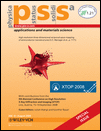Structural changes and peculiarities of NiPdSi formation investigated by Raman and Auger spectroscopy
Abstract
In this contribution we report on peculiarities of formation, structural and vibrational properties of compositional (alloying) nickel silicides such as NiPdSi. MicroRaman analysis has shown that NiPdSi films are thermally stable up to 900 °C, which is by 100 °C higher than that for pure NiSi films. Using Miedema's model we have calculated the heat of formation for NiPdSi to be by 4 kJ mol−1 smaller than that for pure NiSi. This demonstrates an essential role of Pd in the enhancement of thermal stability of NiSi and in retardation of NiSi2 phase formation. Raman spectra registered for NiPdSi show the peaks at wavenumbers typical for NiSi, although red shifted, as well as new Raman peaks at 322 and 434 cm−1 reported recently in [Karabko et al. J. Appl. Phys. 105, 033518 (2009)]. We have assigned these two peaks to the compositional disorder, introduced by the presence of Pd alloy. By means of Auger electron spectroscopy (AES) we have determined the peculiarities of the element distribution and Pd diffusion in NiPdSi and NiSi films, which results in a slight lack of silicon in the stoichiometry of phases and exponential decay law of Pd distribution with temperature.




